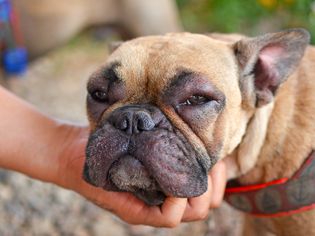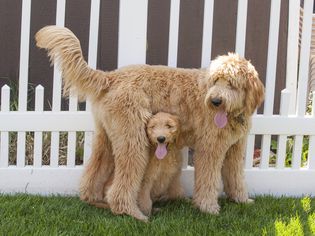Silken Windhound: Dog Breed Characteristics & Care
The silken windhound is a medium-sized sighthound breed developed in the United States. True to its name, this breed has a medium-long silky coat that comes in various colors, including black, tan, brown, gray, red, silver, white, or a combination of colors.
Bred as a smaller, more sociable version of the borzoi, this breed combines the grace of a coursing hound with the affectionate nature of a devoted family pet. These dogs are known for their gentle temperament, intelligence, and eagerness to please, making great companions for active households.
Learn more about the silken windhound’s characteristics, history, and care needs.
Breed Overview
GROUP: Hound
HEIGHT: 18.5 to 23.5 inches
WEIGHT: 22 to 55 pounds
COAT: Straight, slightly wavy, or curly
COAT COLOR: Black, tan, brown, gray, red, silver, or white, or a combination of colors
LIFE SPAN: 14 to 18 years
TEMPERAMENT: Intelligent, friendly, athletic, loyal, affectionate
HYPOALLERGENIC: No
ORIGIN: United States
Characteristics of the Silken Windhound
“Silkens were developed with the goal of being easy companions to their people,” Lisa Golebiewski, PhD, vice president of the International Silken Windhound Society (ISWS) says. “Many owners will describe their silkens as sweet, goofy, snuggly, laidback, intuitive, and velcro dogs.”
Golebiewski adds that this breed loves being around their people, whether it’s working (training or sporting events) or cuddling on the couch in their downtime. Silken windhounds also tend to get along well with children and other dogs. While they do have a natural prey drive, many can comfortably live with cats, especially if raised together from a young age.
Silken windhounds are not natural watchdogs or heavy barkers but may alert their owners to unfamiliar visitors.
| Affection Level | High |
| Friendliness | High |
| Kid-Friendly | High |
| Pet-Friendly | Medium |
| Exercise Needs | High |
| Playfulness | Medium |
| Energy Level | Medium |
| Trainability | High |
| Intelligence | High |
| Tendency to Bark | Low |
| Amount of Shedding | Medium |
History of the Silken Windhound
The silken windhound was developed by borzoi breeder Francie Stull, who sought to create a smaller, long-coated sighthound with a gentle temperament, good health, and the sporting abilities of the larger sighthounds.
The foundation dogs were carefully chosen from top-winning show and performance borzoi lines, a multi-generational line of small whippet-based lurchers, and whippets from show and coursing lines. The first recognized silken windhound litter was born in 1985, and the breed was officially named in 1998. The International Silken Windhound Society (ISWS) was established in 1999 to maintain pedigrees and DNA-verified registrations.
Although not yet recognized by the American Kennel Club (AKC), the United Kennel Club first recognized the silken windhound in 2011.
Silken Windhound Care
Like any dog, silken windhounds require regular activity, mental stimulation, consistent training, and occasional grooming to keep them happy and healthy. Here’s what you need to know about their care needs.
Exercise
“For puppies, the general consensus is silken puppies (and sighthound puppies in general) should have regular access to large enclosed outdoor spaces for ample free running,” Golebiewski says. “This encourages appropriate muscle and skeletal growth in the puppy.” She adds that, if possible, having a second silken windhound or other puppy that enjoys zooming around will help them get enough activity.
Adult silken windhounds need about 60 minutes of daily exercise to stay physically and mentally healthy. Golebiewski notes that regular walks are usually enough to keep them happy, though, as natural athletes, they also enjoy activities like hiking, agility exercises, obedience trials, rally, and lure coursing. Because they have a strong prey drive, they should always be exercised in a fenced area or on a leash.
After an active outing, Golebiewski says most silkens are happy to settle in for a relaxing nap on the couch.
For mental stimulation, puzzle toys, scent work, and trick training can help keep them engaged.
Grooming
Silken windhounds have a medium-to-long silky coat that requires minimal grooming. Their coat naturally repels dirt and doesn’t mat easily, making them lower maintenance than many long-haired breeds. Brushing your silken once a week will help prevent tangles and remove loose fur.
According to the ISWS, the amount that a silken sheds varies on the dog, but they do not blow their coats like other long-haired breeds, such as golden retrievers or borzois. They may shed more during seasonal coat changes in spring and fall.
Nail trimming (every two to three weeks), daily teeth brushing, ear cleaning, and occasional bathing (about once a month) are also essential to maintain their overall hygiene and health.
Training
Silken windhounds are intelligent and eager to please, which makes them relatively easy to train using positive reinforcement. This entails rewarding good behavior with treats and praise, which helps reinforce desired actions.
Training should start early, with basic commands and socialization beginning around eight weeks old. Puppy training classes, along with regular exposure to new people, environments, and experiences, will help them develop into confident, well-mannered adults.
While a silken windhound’s prey drive can be strong, recall training can be improved with repetition and positive reinforcement, especially when introduced at a young age.
Common Health Problems
Silken windhounds are a remarkably healthy and long-lived breed, with many living into their mid to late teens—and some even reaching 20 years old! Careful and selective breeding has helped preserve the breed's overall health.
While health issues in silken windhounds are generally rare, the most commonly seen conditions include:
- MDR1 sensitivity: A genetic mutation that makes them sensitive to certain medications. A simple DNA test can determine if a dog carries this gene.
- Cardiac issues: While uncommon, there have been reports of mitral valve disease, congenital heart abnormalities, and sudden cardiac events in some silkens. Regular veterinary checkups can help monitor heart health.
- Eye conditions: Collie Eye Anomaly (CEA) and other inherited eye disorders may occur in some silkens. Routine eye exams are recommended to catch any issues early.
- Autoimmune thyroiditis: An immune-related disorder that can lead to hypothyroidism. Regular thyroid function tests can help with early detection and management.
Diet and Nutrition
Like all dogs, silken windhounds thrive on a high-quality, well-balanced diet tailored to their age, size, and activity level. Their diet can consist of kibble, fresh or raw dog food, or a mix of both. Golebiewski recommends choosing a food that meets AAFCO standards for their appropriate life stage. Most adult silkens do best with two meals daily, but puppies may require three to four smaller meals as they grow.
Golebiewski notes that as a dolichocephalic (long-nosed) breed, silken windhounds produce less saliva and slobber than some other dogs, which can make them more prone to dental issues. To help maintain their oral health, she recommends regular teeth brushing and incorporating dental chews.
Where to Buy or Adopt a Silken Windhound
Silken windhounds are a relatively rare breed, so they’re not commonly found in shelters or rescues. However, it doesn’t hurt to check adoption sites like Adopt a Pet, as silken windhounds may occasionally be available for adoption in your area. You can also check in with Silken Windhound Health and Rescue.
Reputable silken windhound breeders typically produce only one or two litters yearly, so finding an available puppy to purchase can take time. Staying in touch with breeders and joining breed-specific networks can improve your chances.
Purchasing a silken windhound puppy generally costs $2,000 to $4,000, depending on factors like breeder reputation, lineage, and location. Before purchasing, always confirm that the breeder conducts health testing, provides early socialization, and adheres to ethical breeding practices.
For additional details about this breed and resources for finding a reputable breeder, check out:
- International Silken Windhound Society (ISWS), the official breed club maintaining pedigrees and breed standards
- Silken Windhound Club of America
Silken Windhound Overview
The silken windhound is a graceful, medium-sized sighthound admired for their friendly temperament, athleticism, and soft, flowing coat. This breed thrives in active households, balancing a love for play and activity with time for quiet relaxation at home.
Silken windhounds are intelligent, eager to please, and respond well to positive reinforcement training. They are generally a healthy and long-lived breed.
Pros of the Silken Windhound
- Known for being friendly, easygoing, and social
- Relatively free of major health issues, with many living into their late teens
- Love to run and play but are also content to lounge at home
Cons of the Silken Windhound
- Relatively rare dog breed, meaning longer waitlists for puppies and fewer adoption opportunities.
- May instinctively chase small animals, making them less suited for homes with small pets unless properly socialized.
- Instinct to chase can make recall training challenging, so they should only run freely in securely fenced areas.
More Dog Breeds and Further Research
Not sure if a silken windhound is the right fit? Look into similar breeds, such as:
- Borzoi
- Whippet
- Sloughi
- Greyhound
There’s a whole world of dog breeds out there—with some research, you can find the perfect match to bring home.
- Is a silken windhound the same as a borzoi?
No. While silken windhounds and borzois share a sighthound lineage, they are distinct breeds. Silken windhounds were developed as a smaller, more social version of the borzoi by breeding borzois with whippet-based lurchers.
Are silken windhounds good pets?
Yes! Silken windhounds make excellent pets for the right home. They are affectionate, social, and adaptable, forming strong bonds with their families. While they love to run and play, they also enjoy lounging indoors and are generally easygoing companions.How much do silken windhounds cost?The price of a silken windhound puppy from a reputable breeder typically ranges from $2,000 to $4,000, depending on factors like breeder reputation, lineage, and location. Because they are a rare breed, there may be waitlists for available puppies.
RECOMMENDED NEWS

Can Dogs Eat Edamame? Safety, Benefits, and Prep Tips
Can dogs eat edamame? Yes, your pup can enjoy small amounts of plain, shelled edamame as ...

Why is My Dog's Face Swollen?
A dog's swollen face typically indicates a secondary problem. It can be an allergic r...

How Much Are Goldendoodles?
If you are hoping to add a goldendoodle puppy to your family, you might be wondering how ...

17 Best Dogs for Seniors
Just because you are getting older or are retired doesn't mean your dog-owning days a...

9 Wild Facts About Wolf Dogs
From classic literature (we're looking at you, White Fang), to Game of Thrones and fa...

Miniature Pinscher (Min Pin): Dog Breed Characteristics & Care
The miniature pinscher is a toy dog breed from Germany that actually isn't related to the...






Comments on "Silken Windhound: Dog Breed Characteristics & Care" :